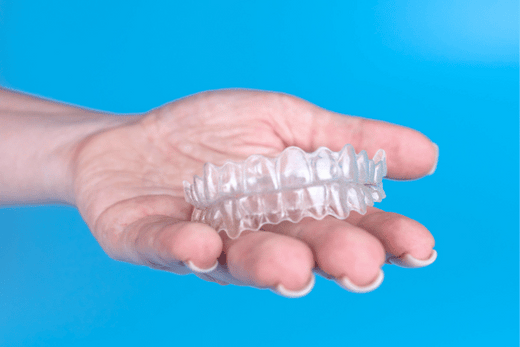
A woman holding clear aligner trays
Introduction
Malocclusion, a misalignment of the teeth or incorrect relationship between the teeth of the two dental arches, is a prevalent dental issue that affects a significant portion of the population. While traditional braces have been the go-to solution for many years, there's a rising trend in recommending invisible teeth straightening methods. In this article, we will delve into the reasons why clear braces are becoming a preferred choice for addressing malocclusion.
1. Aesthetics and Confidence
One of the primary reasons individuals opt for invisible teeth straightening is the aesthetic advantage it offers over traditional braces. Unlike the noticeable metal brackets and wires, invisible aligners are virtually undetectable, allowing individuals to undergo orthodontic treatment without feeling self-conscious. This aesthetic benefit contributes significantly to improved confidence during the treatment process.
According to Dr. Ather, A USA licensed Orthodontist “People often use the term cosmetic teeth straightening, which is not an orthodontic term, however, when you use treatments to fix your bit, it can be aesthetically pleasing as well.”
Find out more about teeth straightening in our podcast.
https://www.youtube.com/watch?v=osX99mglEMw
2. Comfort and Convenience

Invisible teeth straightening involves the use of custom-made clear aligners that are removable. This not only provides a higher level of comfort but also offers unparalleled convenience. Unlike traditional braces, which may cause discomfort and difficulty in cleaning, invisible aligners can be easily taken out for eating, brushing, and flossing. This convenience factor is particularly appealing to individuals with busy lifestyles.
"Teeth straightening is not just about creating a perfect smile; it's about fostering a perfect harmony between oral health, confidence, and a radiant self."
3. Predictable Results with Advanced Technology
The technology behind invisible teeth straightening has advanced significantly in recent years. Computer-aided design (CAD) and 3D printing technology are now utilized to create precise and customized aligners. This ensures a more accurate and predictable outcome in terms of teeth alignment. Patients can visualize the expected results before starting the treatment, adding a sense of assurance and transparency to the process.
4. Reduced Treatment Time
Invisible teeth straightening often results in a shorter overall treatment time compared to traditional braces. The treatment duration varies from person to person, but the innovative technology used in invisible aligners can expedite the teeth straightening process. This can be particularly appealing to individuals seeking a more time-efficient orthodontic solution.
5. Minimal Impact on Daily Activities
Traditional braces can restrict certain activities, such as playing musical instruments or participating in contact sports. Invisible aligners, being removable, allow individuals to engage in their regular activities without significant interference. This adaptability makes invisible teeth straightening a practical choice for people with diverse lifestyles.
Conclusion
Invisible teeth straightening has emerged as a contemporary and effective solution for addressing malocclusion. The combination of aesthetic appeal, comfort, advanced technology, shorter treatment duration, and minimal impact on daily activities makes it a compelling choice for those seeking orthodontic treatment. As the field of dentistry continues to evolve, the popularity of invisible teeth straightening is likely to grow, providing individuals with a discreet and efficient way to achieve a beautifully aligned smile.
Transform your smile with Alignerco – your pathway to discreet and effective teeth straightening. Discover the benefits of invisible aligners tailored to your needs. Take the first step towards a confident smile today!
FAQs
1. Can anyone use invisible teeth straightening, or is it only suitable for specific cases?
Invisible teeth straightening is suitable for various cases of malocclusion, but the severity of the misalignment may influence the treatment options. It's best to consult with an orthodontic professional to determine if invisible aligners are the right choice for your specific situation.
2. How long does the treatment with invisible aligners typically take?
The duration of treatment with invisible aligners varies from person to person. On average, it can range from a few months to a couple of years, depending on the complexity of the malocclusion. Your orthodontist will provide a personalized timeline based on your individual needs.
3. Are invisible aligners as effective as traditional braces in correcting malocclusion?
Yes, invisible aligners are highly effective in correcting malocclusion. The technology used in these aligners, including CAD and 3D printing, ensures precise and customized treatment plans. However, the effectiveness may depend on the commitment of the individual to wear the aligners as instructed.
4. How often should I wear the invisible aligners each day?
For optimal results, it's recommended to wear invisible aligners for 20 to 22 hours per day. They should only be removed for eating, drinking (except water), brushing, and flossing. Consistent wear is crucial to ensure the treatment progresses as planned.
5. Is professional oversight included in at-home aligner treatments?
Invisible aligners are designed to be removable, allowing you to eat and speak comfortably without interference. While there may be an initial adjustment period, most individuals adapt quickly to the aligners. It's important to follow the guidelines provided by your orthodontist to ensure a seamless integration into your daily routine.


